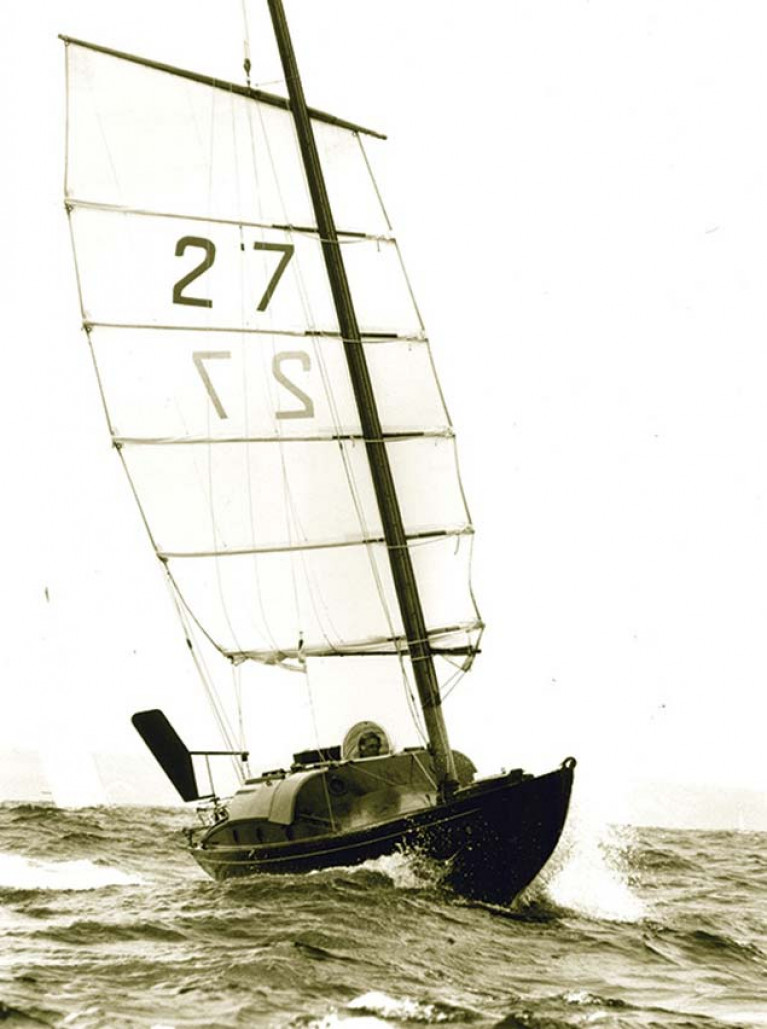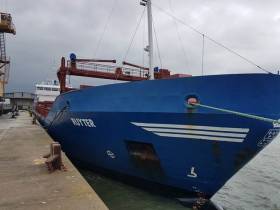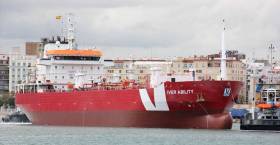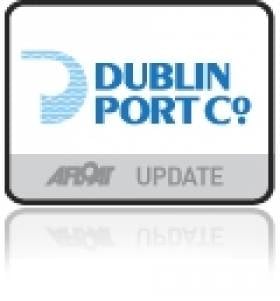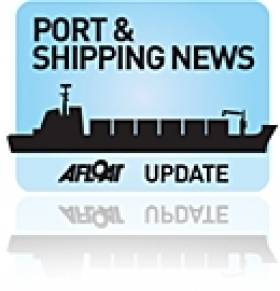Displaying items by tag: Cargo
Ship With Cargo of Boats Adrift Off Norwegian Coast
The crew of a Dutch cargo vessel were rescued by helicopter as their ship developed a heavy list in the Norwegian Sea late on Monday (5 April).
Now there are concerns that the Eemslift Hendrika, which remains adrift with its cargo of boats, could capsize and cause a serious pollution incident.
According to Marine Industry News, shifting cargo on deck caused the vessel to destabilise amid extreme weather with 15-metre swells some 60 miles off Ålesund in Norway.
Dramatic footage from Norway’s coastguard shows some the 12 crew leaping into the water as the vessel listed dangerously.
Along with its cargo of boats, including a motor yacht, the Eemslift Hendrika has some 350 tonnes of heavy oil and 50 tonnes of diesel fuel.
“What is important is that we now get measures taken so that we can prevent the vessel from posing an environmental hazard. That is our main focus,” Hans Petter Mortensholm of the Norwegian Coastal Administration said.
Marine Industry News has more on the story HERE.
Can Ireland’s Wind Power Drive Modern Trading Ships?
The wind is free. No-one disputes that. But harnessing its power can be a very expensive business, particularly if you’re trying to do it at the top level of international competition writes WM Nixon. Yet at a more mundane level of sailing, with auxiliary sail power working in support of electric main engines, we should surely be able to develop cargo-carrying vessels which can work along the coast of Ireland and across the oceans with a minimal carbon footprint.
Their very existence would increase environmental awareness. And their regular functioning could possibly even include an element of Sail Training in their crewing. With this in mind, in a remote and very special place on the Connacht coast, some ideas and proposals of increasing importance have been developing.
Jamie Young of Killary Adventure Centre in far northwest Galway is one of Ireland’s most experienced seafarers, with his nautical skills allied to extensive aspects of mountain-craft to give him an unrivalled overview both of the realities of seafaring, and the techniques of training and leadership.
With the Adventure Centre’s Expedition Yacht being the alloy Frers 49 Killary Flyer (one of the best boats ever in Irish waters), his knowledge of the waters west of Greenland is unrivalled. And while many expect him to be among the first skippers in his category to circumnavigate Greenland, he says it may be some time yet before that happens, for although the passage on Greenland’s west and northwest coasts is slowly clearing north towards Cape Morris Jessup, the ice on Greenland’s far northeast coast continues to present an impassable challenge.
 Killary Flyer among the ice of West Greenland. An alloy-built Frers 49, she has been a successful offshore racer (overall winner of the 1988 Round Ireland Race) and a very effective expedition yacht
Killary Flyer among the ice of West Greenland. An alloy-built Frers 49, she has been a successful offshore racer (overall winner of the 1988 Round Ireland Race) and a very effective expedition yacht
But the Greenland challenge and its deeper implications is only one of many items on the Jamie Young agenda. As he mentions in the following article, his extraordinarily varied and extensive CV includes a period when he and his wife Mary were the core professional crew on shipping magnate Huey Long’s Maxi Ondine.
Huey Long was notoriously parsimonious, so much so that we may do an article about it someday, for Don Street is another Irish-connected sailor who had to deal with it. Yet despite his penny-pinching approach, Long accepted that when the big boats from the small but very keen fleet of Maxis wandered the earth alone like dinosaurs in search of top-level glamorous competition, the most economical way to do the lengthy delivery trips was with minimal crew and entirely under engine.
Crews cost money, Maxis were organized to be sailed with large crews, and their sails were ultra-expensive. So the least expensive method of voyaging was to have a substantial auxiliary engine which was installed in such a way that, at the end of a long delivery, it could simply be lifted out and replaced with a new one. This was standard practice. Yet the business of being just two aboard as the big boat thumped her way through all sorts of weather across the empty ocean towards the next big event could be a soul-destroying business.
 The Maxi Ondine, skippered by Jamie Young
The Maxi Ondine, skippered by Jamie Young
So not surprisingly Jamie’s enthusiasm for eco-friendly means of getting about the seas and oceans in a commercially and possibly socially-useful manner with a positive reliance on sails easily handled with modern technology has become ever-stronger over the years. He takes up the story:
The Sail Trading Project
By Jamie Young
The pull of the sea is strong and once hooked, it becomes central to your being. Very few of my broad family have or had the faintest interest in the sea, but after my first sail in the late 1950s with one of my cousins, I was hooked.
That cousin happened to be Wallace Clark, renowned for his definitive book about cruising round Ireland. But back in the 1950s, Sailing Around Ireland was yet to be published (it first appeared in 1976), and I was just a small boy who’d been brought along with adults to be taken for a sail somewhere off the coast of Northern Ireland, a small boy who was simply put under the foredeck of the daysailer on which this family obligation was being fulfilled. Yet I became hooked on sailing because of it.
What followed was a continued fascination with the sea and voyaging in various capacities and places: sea kayaking around Cape Horn; sailing Blondie Hasler’s special junk-rigged Folkboat Jester to the USA with Mary for our honeymoon; working as Skipper on the Maxi Ondine on many oceans; solo participant in another engine-less boat in the ’76 OSTAR - and solo return; the AZAB to the Azores and back; the Three Peaks; and many other voyages that I felt lucky to be able to enjoy, including more recently two to the West Coast of Greenland.
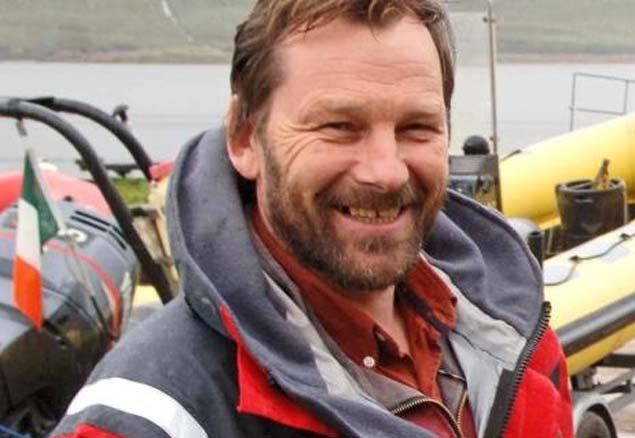 Man of the mountains, man of the sea - multiple adventurer Jamie Young of Killary. He feels that traditional sail training may have had its day and that to be meaningful, it now needs to be allied to some form of commercial sailing.
Man of the mountains, man of the sea - multiple adventurer Jamie Young of Killary. He feels that traditional sail training may have had its day and that to be meaningful, it now needs to be allied to some form of commercial sailing.
The stories and the reasons that surround these experiences are for another time. But all seem to have led to a specific interest which has led to many queries branching outwards towards an exciting and necessary future in what I call ‘Sail Trading’.
Having been part of the big boat racing circuit - albeit 40 odd years ago - I remain fascinated by the latest racing machines, including short-handed, solo, fully crewed, Round the World, and America’s Cup. Yet I can’t help but wonder why this fast-adapting technology cannot be put to another parallel use, and create efficient cargo sailing/renewable energy combination vessels.
And I would include creating some tech to prevent the increasing prevalence of vessels, sail and cargo, hitting and killing marine life or causing damage to both parties, for although this gruesome image results from a whale and ship collision, does anyone think when an IMOCA 60 at thirty knots is damaged by its keel hitting a whale, that the unfortunate whale is not also seriously and possibly fatally injured?
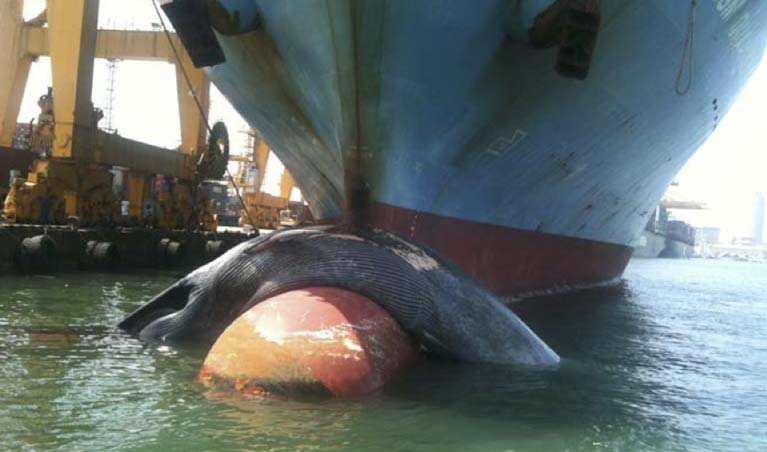 The tragic result of vessels in a hurry – a fatally injured whale impaled on the bow-bulb of a big ship
The tragic result of vessels in a hurry – a fatally injured whale impaled on the bow-bulb of a big ship
We can no longer have contempt for our natural environment, and as foils increase speeds to be seen as lethal cutting instruments, we should pause for thought…. Since we now have digital Doppler radar that can spot a buoy miles away, where is the responsibility and options to make a positive contribution to sustaining ocean wildlife? As Gandhi said: ‘There is more to life than just increasing its speed’.
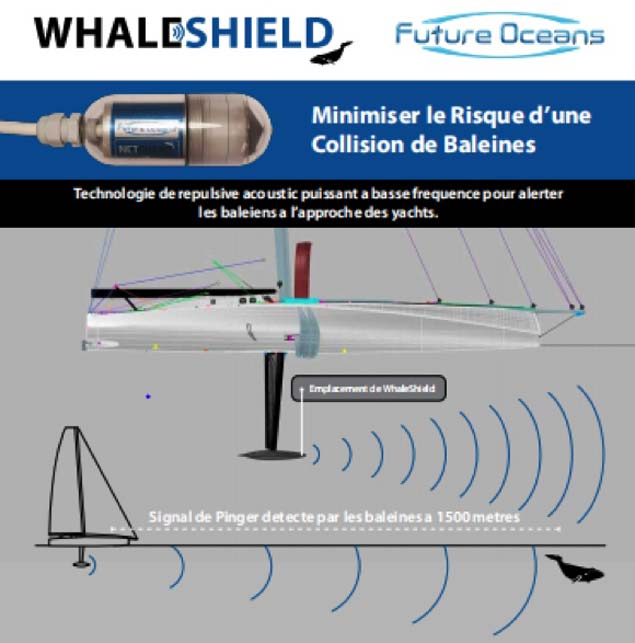 The Future Oceans group have created the Doppler radar Whaleshield
The Future Oceans group have created the Doppler radar Whaleshield
On a more positive note and back to ‘Sail Trading’, there is now a growing effort to consider again using the wind to power cargo vessels and ideally, it’s time for Ireland to get involved as an island nation, bearing in mind the historical trading activity between France and Iberia from Ireland’s west coast, from which the likes of Grace O’Malley and Daniel O’Connell greatly benefitted.
An interesting Irish connection that has blossomed into a regular transatlantic trade - both goods and passengers - is the Brigantine Tres Hombres. She was once a ferry to the Aran Islands from Galway in the ’70s and called Boidin. But she did start her life in the Baltic, and I am sure has many stories buried in the woodwork of her long life. She was discovered abandoned in Galway docks, towed back to Holland and slowly rebuilt to modern standards into the vessel you see today.
 The commercial sailing ship Tres Hombres is the former Aran islands ferry Boidin
The commercial sailing ship Tres Hombres is the former Aran islands ferry Boidin
There are encouraging new builds, with some based on traditional lines as in the project CEIBA in the jungles of Costa Rica. This is fast taking shape, the difference being that she will have an electric auxiliary motor powered by renewables. The pictures show what the outcome will be, and she is now framed with the photo showing the full size lofting floor beside her present build. Her trading plans are more local to Costa Rica and around the Gulf of Mexico, but who knows what more distant opportunities may arise.
 The Costa Rican Three-Master will be run as a commercial trading vessel
The Costa Rican Three-Master will be run as a commercial trading vessel The Costa Rican three-master is in build in traditional timber style
The Costa Rican three-master is in build in traditional timber style
There are also a number of forward-looking projects that are looking at new technologies or adapting existing ones and these are equally fascinating. Energy Observer was originally a Nigel Irens catamaran from 1983, perhaps best known as ‘ENZA New Zealand’ when Sir Peter Blake and Sir Robin Knox Johnston set records with her. After only just returning from an initial round the world, she has been lengthened and further adapted for another four-year circumnavigation using purely renewables, while most interestingly creating hydrogen via solar as part of the motive power, which will also be augmented with rotating sails which are called ‘Oceanwings’:
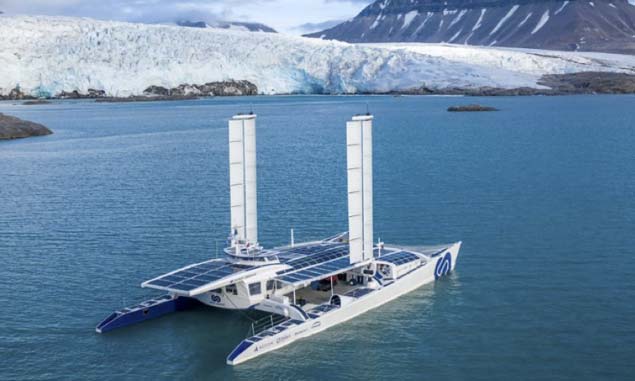 Originally the Nigel Irens catamaran ENZA New Zealand, Energy Observer has been lengthened for a second circumnavigation entirely using renewable energies and her oceanwings rotating sails
Originally the Nigel Irens catamaran ENZA New Zealand, Energy Observer has been lengthened for a second circumnavigation entirely using renewable energies and her oceanwings rotating sails
More interesting again are two orders for sail-assisted large cargo vessels for a particular transatlantic route, mainly machinery deliveries. The first build is recently announced and under way from Neoline:
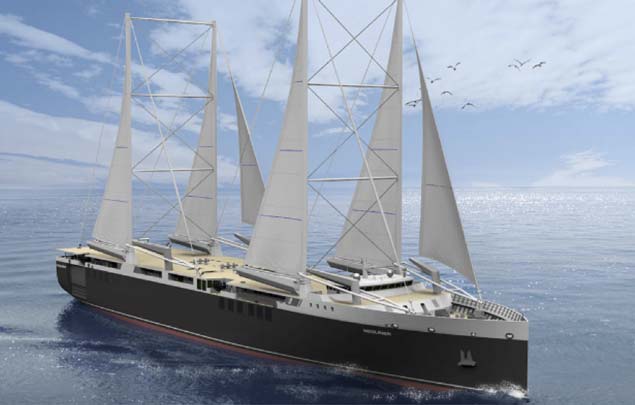 Two of these sail-assisted large cargo vessels from Neoline are currently in build
Two of these sail-assisted large cargo vessels from Neoline are currently in build
What I am most interested in initially is the build and operation of a multi-use sail trading vessel based on the current Votaan 72 example under construction in France. This is being built in the Alumarine-shipyard at Saint-Nazaire, near Lorient in Brittany.
The Votaan 72 is planned to have a 35-ton cargo capacity - 72 feet long - made of aluminium so minimum maintenance costs - nearly 100% recyclable - Two masts - 4 crew.
 The Votaan 72 is building in France in aluminium
The Votaan 72 is building in France in aluminium
This project is of a size and scale that makes it possible from several directions: finance - maintenance - crew - access – materials. And it shows that with breadth of vision, we can think of it in multi-use terms. And what does ‘Multi-use’ mean? To make this a viable enterprise in the first instance, the roles envisaged would be:
- Cargo vessel between set ports on a common route. This might suit a corporate body that is prepared to ship by ‘traditional’ means and benefit from this exposure - with professional marketing input.
- As a marketing tool for a selection of companies to different ports where a mini ‘trade show’ can be held - again with professional marketing input - at those chosen destinations.
- As exposure to the sea for trainees not just from a traditional perspective of sea time, but access to transferable skills more modern in nature - and skills not confined to the marine sector.
- These skills would consist of: use of the comprehensive digital tools now available to mariners - interspersed with use and understanding of traditional methods of navigation and weather forecasting - and dealing with life on board out of sight of land and with no TV/internet…..
- This process could be increased by having the ability to adapt the vessel from a crew max of 6 on regular routes, while also adapting the cargo area to a max of 12 passengers on more defined sailing experiences.
- This would be all about the spirit of adventure and youth development, but with a modern twist that could include the transferable skills mentioned.
- Part of this would, therefore, be the ability to ship at set times the adventure sports equipment which allows for shore experiences. (Kayaks - camping - photography - etc.), and the possibility of research projects that can contribute to the development of further climatic solutions.
- Encourage a program of plastic & general rubbish collection on some of Ireland’s more remote coastline locations and islands.
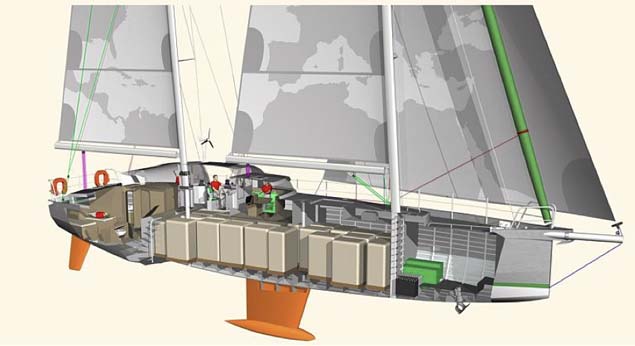 The Votaan 72 cargo space can be re-purposed to provide extra crew accommodation
The Votaan 72 cargo space can be re-purposed to provide extra crew accommodation
With some regret, I am further of the opinion that traditional sail training or personal development style voyages and ships, while they have their place, are not where the future lies in this area, and certainly not in Ireland. We have to excite and encourage by osmosis and foster a lifelong interest in all things maritime, including an interest in adopting new technologies in other areas that lessen mankind’s climate footprint.
There may be other such uses, but the initial emphasis will be on variety while the project crystallises. This is based on the first instance, however, it is planned, that once the concept stabilizes, a more complete and structured program will emerge.
Because this concept is what you could call a “Re-emerging Trend”, with the correct business structure it is possible that after a number of years the vessel would be sold on and another ‘improved’ version built. Maybe: bigger - more efficient - using now established cargo routes - re looking at possible technological advantages - looking towards new and/or different markets.
FINANCE
The overall monetary concept is to create a self-financing model of operation, and indeed - in time - to make it a profitable enterprise. This will require accountancy skills way beyond my level of competence, however, though I might have notions…!
As my Arctic sailing vessel ‘Killary Flyer’ is presently berthed at the friendly and efficient Mooney’s Boatyard in Killybegs, whenever I visit I am amazed at both the size and complexity of the huge fishing vessels moored up. Never mind the international examples raping the west coast on ‘MarineTraffic’, surely there must be a financial lesson there?
Thus, there are a couple of models to consider:
- Tax-efficient trading company based on purely commercial considerations, suitable for corporate investment. Trading with varied high-value cargo - not time-specific between set ports.
- Sourcing funds from an EU project. These might be a little light in view of current circumstances globally…
- Crowdfunding to the Irish - and other - diaspora. This is a comparatively new method of raising funds, but with my purchase of an electric bike via Indigogo last year - where they managed to raise €16M – it certainly provides food for thought.
- And crowdfunding comes - as far as I am aware - in two styles: creating a product that funders get at a discount when successfully launched – it’s basically seed money.
- Or where the visuals/story created are the story, which is funded via regular online postings. It is now longer possible to ‘disappear over the horizon’ thus, as Point F above, one of the skill sets to be developed by groups is social media engagement. With new satellite launches now regular and Inmarsat/Iridium prices falling, it is expected this would be a key tool of contact and interest in real-time.
- The purpose of this project/article, therefore, is to demonstrate that we are on the cusp of further strong sea transport evolution and Ireland should get on board and use its island position to develop this capacity and help benefit and encourage some of the youth of today, in an economical and affordable manner.
As the author, I intend to work away at the concept and believe this article will prompt others to get involved and I would encourage any reader to get in touch with queries - ideas - and help with the financials… Most of my ideas, whether it was sailing to Greenland or sea kayaking around Cape Horn, or indeed setting up a business in the west of Ireland during the ’80s, were greeted with astonishment. But here we are….
Nothing is set in stone at this stage and I am always receptive to solid worthwhile input, indeed I thrive on it.
Do we want to be one of the leaders of the pack in both modern youth engagement and exploring small vessel renewable trade?
Captain Fined Over Negligence After Cargo Vessel Grounding
#Shipping - The captain of a cargo ship that ran aground on Rathlin Island last week has been fined £1,000 over his negligence at the helm, as the Belfast Telegraph reports.
The MV Ruyter, which was en route from Russia via Denmark and Scotland, sustained extensive damage to the front of its hull after running aground on the north side of Rathlin Island on the night of Tuesday 10 October.
However the damage was not noted till the vessel arrived at Warrenpoint in Carlingford Lough the following afternoon.
At a sitting of Armagh Court, Judge Paul Copeland found that Aleksandr Iakovotsov had broken international shipping codes over failure to keep a lookout to judge risk of collision, and a separate charge of failing to provide sufficient lookout “during the hours of darkness”.
The Belfast Telegraph has more on the story HERE.
Christmas on Dublin Bay for 'Iver Ability' Tanker, Investigation into 'Cargo Reaction'
A red–hulled ship and her crew at anchor on Dublin Bay since August are set for a lonely Christmas on the capital's waters. The long term anchorage of the 'Iver Ability' follows a fire onboard the Asphalt/Bitumen Tanker during her transport of Bitumen into Dublin Port this summer.
This morning the ship is one of only two located in the Port's designated anchorage in the Southern Bay.
Initial enquires about what sources told Afloat.ie was 'an explosion' on board the ship drew a 'no comment' response from port authorities. This week the Dutch ship managers told Afloat.ie the 129m–vessel is the 'subject of an investigation' into how its cargo experienced a 'reaction' during operations in August.
Managers Iver Ships say following the reaction the 2006–built vessel was transferred to anchorage where she has become a talking point for many Dubliners around the shores of Dublin Bay.
The situation has, say the managers, 'stabilised with no further pressure release of the cargo occurring'. The exact cause of the cargo’s reaction is yet unknown. A full investigation is being conducted.
Iver Ability is currently still at anchorage in the port of Dublin and fully operational with all seafarers performing normal duties and standard crew changes taking place.
Discussions with charterers are ongoing on a port of discharge for the vessel’s cargo.
Dublin Port Cargo Volumes Rise 5.3% in Q1
#cargodublin – Dublin Port Company today published trade statistics for the first quarter of 2015. The figures show continued growth in import and export trade at Ireland's largest port with cargo volumes up 5.3% on the same period last year. This is the strongest first quarter Dublin Port has had in a decade and surpasses the previous record year of 2007 by 3.0%.
Total throughput (imports and exports) for Q1 2015 was 7.8 million gross tonnes, an increase of 5.3% on the 7.4 million tonnes handled in the first quarter last year. There were 1,642 ship arrivals in the first three months. Imports were particularly strong in Q1 at 4.7 million gross tonnes, while exports reached 3.1 million gross tonnes, up 6.9% and 3.0% respectively on Q1 2014 trade levels.
The overall strong growth was driven by a combination of increased movements of unitised goods (containers and trailers) and by imports of petroleum products. Whereas the recovery in Dublin Port's volumes has been export led in recent years, in more recent times there has also been strong growth on the import side as the domestic economy improves. The 8.5% increase in petroleum imports is particularly striking.

Imports of new cars and commercial vehicles continued to grow very strongly with almost 33,000 (32,917) new vehicles imported through Dublin Port in the first three months of the year, up 38.8% on the same period last year. With more people purchasing and registering new vehicles, Dublin Port is well placed to accommodate this increase having opened a new €3.4m 4.2 hectare trade car terminal last year as part of the port's Masterplan 2012 to 2040. Located on East Wall Road, the new trade car terminal can handle 2,500 vehicles at a time.
Unitised trade grew strongly in both the Ro-Ro and Lo-Lo modes. Compared to the same period last year, Ro-Ro trailers moved ahead by 7.2% to 207,042 and the port's Lo-Lo container business increased by 7.3% to 146,156 TEU.
The continued growth in unitised business reaffirms Dublin Port as the island's port of choice for both Ro-Ro and Lo-Lo services. Ro-Ro is Dublin Port's biggest mode and the large growth in Ro-Ro has been driven by increased sailings to both Britain and Continental Europe. There are now 12 daily sailings for passengers and 14 daily sailings for freight to Britain plus five weekly Ro-Ro sailings to Continental Europe.
On the tourism side, Dublin Port attracted 277,269 ferry passengers in the first three months of the year, a 5.0% increase on the first quarter of last year. Dublin Port expects continued growth following Stena Line's recent consolidation of its ferry services into Dublin Port and its introduction of a new ship (Stena Superfast X) on the Dublin to Holyhead route.
Eamonn O'Reilly, Chief Executive, Dublin Port Company, said: "Dublin Port's latest trade figures continue the positive trends of recent years. Our volume grew by 5.3% in the first quarter of 2015. This follows growth of 7.0% in 2014 and 3.0% in 2013, putting Dublin Port back on our Masterplan's growth trajectory which will see volumes double over the period from 2010 to 2040.
"Dublin is the chosen route for imports and exports because of our direct access to most of Ireland's population and frequent shipping services to Ireland's markets in Britain, Continental Europe and beyond. Ferry passengers benefit from a choice of operators and frequent services to and from Dublin Port, bringing them into the heart of the city and with immediate access to the M50 and the country's motorway network.
"We are expanding the capacity of Dublin Port to cater for future growth with a focus on working within the existing footprint of the port and maximising the use of existing port lands. Our plans include the lengthening and deepening of the port's berths and shipping channel and the redevelopment of existing lands for more intensive cargo handling.
"Our current plans are centred on the Alexandra Basin Redevelopment Project which we hope to commence during 2015. In addition to providing additional capacity for cargo, this project will allow us to bring the world's largest cruise ships right up to the East Link Bridge."
Dublin Port Company Opens New Alexandra Quay Container Terminal
#dublinport – Dublin Port Company today officially opened its newly completed Alexandra Quay Container Terminal following a €35m investment. The opening was welcomed by The Minister for Transport, Tourism and Sport, Paschal Donohoe, T.D.
The opening marks the completion of the third and final phase of the development of the new facility. This third phase will enable the terminal to cater for an additional 80,000 TEUs (twenty foot equivalent units) per annum bringing the terminal's total capacity to over 400,000 TEU per annum.
The initial two phases of the project created new runways for three rows of rubber tyred gantry cranes (RTGs), a type of large mobile crane used for stacking shipping containers.
The third and final phase added a fourth runway for RTGs and deepened and strengthened the quay wall to allow bigger container ships to be loaded and discharged with modern high speed ship-to-shore gantry cranes.
The terminal's operator, Burke Shipping Group, has invested in a new seventh RTG and will take delivery of a ship-to-shore gantry crane later in the year. Both of these new cranes are being supplied by Liebherr of Killarney. The finished terminal has an area of 10.7 hectares and the completed development comes at a time when Dublin Port's full year trading figures show a 7% increase for 2014, equalling the record levels of 2007.
Minister for Transport, Tourism and Sport, Paschal Donohoe, TD, said: "I congratulate Dublin Port Company on the completion of the development of this new container terminal. The €35 million investment by Dublin Port Company is significant and represents a sustainable approach to planning for the long-term capacity and infrastructure needs of Dublin Port and its customers. The fact that trade levels for 2014 are on a par with 2007 is testament to the hard work and commitment of all at Dublin Port Company who are driving the company forward and ensuring that Dublin Port plays to its full strengths in delivering for our economy and for our continued growth and development."
Eamonn O'Reilly, Chief Executive, Dublin Port Company said: "Dublin Port Company is proud to open the newly completed Alexandra Quay Container Terminal today. We have invested €35 million to develop this facility so that Dublin Port can continue to facilitate growth in the economy and meet the needs of our customers and Dublin as a port city. This project is a clear example of how Dublin Port Company is finding innovative ways to address demand for increased capacity and modernised infrastructure using the port's existing footprint. I am confident that this timely and sustainable investment, delivered through a successful public private partnership, achieves this important objective for Dublin Port.
Lucy McCaffrey, Chairperson, Dublin Port Company said: "Dublin Port Company's Masterplan includes a commitment to use the port's existing lands to the greatest extent possible. This is a very tangible example of how Dublin Port Company is continuing to act on this commitment. The completion of the Alexandra Quay Container Terminal gives Dublin Port additional container handling capacity and more modern port infrastructure that will benefit not only the port, but its customers and the wider economy in the immediate future and for years to come."
Dublin Port Post 2014 As Record Year For Trade
#dublinport – Dublin Port Company today published trade statistics for 2014 which show a record year for trade at Dublin Port, with growth year-on-year of 7.0%. The stats follow a weekend interview with Dublin Port Company Chief Executive, Eamonn O'Reilly who mapped out the future for Ireland's major shipping port.
Total throughput for 2014 was 31 million gross tonnes with 7,108 ship arrivals in the year, bringing the port's activity back to the record levels of 2007.
Imports in 2014 were over 18 million gross tonnes, while exports exceeded 12 million gross tonnes, representing increases of 6.3% and 8.0% respectively on 2013 trade levels.
The recovery in the Port's trade has been export-led with volumes of exports 1.6 million gross tonnes greater than in 2007. On the import side there has been continuing recent growth (driven by improving domestic consumption) and this has pushed Dublin Port's overall volumes ahead to equal previous record levels of 31 million gross tonnes.
High levels of growth were recorded for trade vehicles, mostly new cars destined for dealerships around the country. The port received 81,169 trade vehicles in 2014, up 33.3% on the previous year. To accommodate the growing number of trade vehicles entering the port, Dublin Port opened a new €3.4 million 4.2 hectare trade car terminal at East Wall Road in October 2014. This new terminal can cater for 2,500 vehicles at a time.
There was particularly strong growth in the unitised modes with Ro-Ro trailers ahead by 7.9% and Dublin Port's Lo-Lo container businessahead by 9.4%. In 2014, the Ro-Ro sector achieved strong results with 821,876 units while Lo-Lo containers finished the year at 565,698 twenty foot equivalent units (TEU). The strong performance of the unitised business highlights Dublin Port as the island's port of choice for both Ro-Ro and Lo-Lo services.
SUMMARY OF TRADE STATISTICS
|
2014 |
2013 |
|
|
Throughput (‘000 gross tonnes) |
30,849 |
28,840 |
|
18,358 |
17,271 |
|
12,491 |
11,569 |
|
Ro-Ro (freight units) |
821,876 |
761,958 |
|
Lo-Lo (TEUs) |
565,698 |
516,872 |
|
Ferry Passengers |
1,710,275 |
1,607,987 |
|
Tourist Vehicles |
462,215 |
428,468 |
|
Trade Vehicles |
81,169 |
60,905 |
On the tourism side, 1.7 million ferry passengers travelled through the port in 2014, representing a 6.4% increase on last year and placing Dublin Port on a par with major airports including Cork and Shannon. In addition, 2014 was a strong year for the port's cruise business with 140,000 visitors on 86 cruise ships.
Eamonn O'Reilly, Chief Executive, Dublin Port Company, said: "2014 was an exceptional year for Dublin Port with a 7.0% increase in cargo volumes on top of the 3.0% we saw in 2013. The port is now back to the record levels of trade recorded in 2007 with every prospect of continued strong growth in the years ahead.
"During 2014, we saw strong increases right across our main business areas, from imports and exports to trade vehicle and ferry passenger numbers. We expect growth to continue into 2015, with importers and exporters choosing to do business through Dublin Port where they benefit from direct access and frequent services to their main markets.
"Dublin Port Company is committed to sustainable investment in port infrastructure and services including the longer, deeper berths envisaged in our Alexandra Basin Redevelopment Project. These will accommodate the larger ships of the future carrying increased cargo volumes and greater numbers of passengers. This type of investment will allow Dublin and the wider economy to prosper by ensuring that Dublin Port is ready to facilitate the future trading needs of its customers and the country as a whole.
"Having completed major investments during 2014 including the new €3.4 million trade car terminal and with the development of the Alexandra Quay Container Terminal nearing completion, we are looking forward during 2015 to commencing the Alexandra Basin Redevelopment Project which the EU is already supporting under its TEN-T infrastructure investment programme."
3% Increase For Irish Port and Shipping Volumes In 2013
#Ports&Shipping - The volume of cargo shipped through Irish ports saw an overall increase of 3% in 2013, with three of the five principle freight segments experiencing growth.
This is according to the 11th annual edition of the Irish Maritime Transport Economist publication.
Irish Maritime Development Office director Liam Lacey commented that the increase gives "cause for greater optimism than has been the case in recent years.
"The volume of trade that moves through Irish ports is a reliable indicator of national economic performance and activity," he added.
“Although traffic through Irish ports has not returned to the levels that were recorded prior to the recession, it is noteworthy that the iShip Index, which is an aggregate measure of trade volumes, rose to 862 points for 2013, up 3% on the previous year."
Within this increase, figures show that Ro/Ro volumes rose by 6% buoyed by transfers from the Lo/Lo mode, while dry-bulk traffic also grew by 6%, resulting mostly from an increased demand for animal feed and coal.
“Additional demand for construction-related materials contributed to break-bulk traffic growing to 961,803 tonnes, up 20% on the previous year," said Lacey, who added that while liquid-bulk and Lo/Lo traffic fell by 14% and 1% respectively, these decreases in volume were caused by market anomalies rather than a reduction in total demand.
Meanwhile, within the tourism sector, Irish ports "continued to capitalise on the global rise in cruise business over the last decade, as vessel calls to the island of Ireland rose to 277 during 2013.
"In this category, the majority of visitors came from North America, Britain and Germany," said Lacey.
Ferry tourism, encompassing services between the Republic of Ireland and Great Britain, also showed an increase of 1% to 2.33 million passengers. "This increase marks an important turning point as growth returns to a market segment that has been in decline since 2010," said the IMDO director.
As for the first four-plus month of 2014, Lacey said preliminary figures "suggest that the trends in the maritime transport sector that were observed in 2013 have continued and that a degree of cautious optimism is justified.”
Commenting on the report, Minister for Transport Leo Varadkar said he welcomed initiatives being undertaken by Ireland's ports "to provide the additional capacity that will be needed as our economy continues to recover and expand.
"I also welcome recent increases in shipping capacity and the development of new trade routes. These developments auger well for economic growth and are supportive of the objectives of the National Ports Policy and the Government’s plan for National Recovery 2011-2016.
"As reported in the IMTE, the international shipping environment remains challenging. Nonetheless, we have begun to see signs of recovery in the Irish maritime sector, as evidenced by the growth in trade, through Irish ports in 2013.”
New Zealand Cargo Ship Wreck Breaks Up in Heavy Seas
#SHIPPING - The Greek-owned cargo ship which ran aground off New Zealand three months ago - described as the country's worst maritime disaster - has split in two in heavy seas.
In a scene thankfully avoided closer to home, with the successful tranfer of 54,000 tonnes of vacuum gas oil from the damaged tanker Germar Companion in Belfast Lough, rough conditions off the New Zealand coast have caused the stern section of the Rena to snap off.
As many as 300 containers were washed overboard, polluting the water with milk powder and other debris, and fears are growing of a new oil spill in the coming days posing a threat to marine wildlife.
According to BBC News, hundreds of tonnes of fuel have spilled into the sea since the ship first ran aground at the Atrolabe Reef off North Island on 5 October, causing the deaths of hundreds of seabirds.
Though more than 1,100 tonnes of oil have been removed from the stricken vessel, some 385 tonnes remain aboard.
BBC News has more on the story HERE.
Successful Transfer of Cargo Completed
#SHIPPING – The successful transfer of 54,305 tonnes of vacuum gas oil from the vessel Genmar Companion to the BW Seine in Belfast Lough is now complete.
The Genmar Companion had been sheltering off the Copeland Islands since reporting a crack on its deck on 16 December. In order for repairs to take place in Belfast Harbour it was necessary to remove the cargo of oil in Belfast Lough by ship to ship transfer; due to there being no shore reception facilities in Belfast Harbour for a tanker of this size. The operation to transfer the vacuum gas oil was delayed several times due to the extreme weather, but was able to commence yesterday (Friday 6 January).
Hugh Shaw, The Secretary of State's Representative (SOSREP) Maritime Salvage and Intervention, said:
"I am delighted that the ship to ship transfer operation has now been successfully completed, the exclusion zone that was in place will be removed at midnight tonight. I would like to take this opportunity to offer my thanks to all concerned with the operation. In particular I would like to thank Fendercare and the masters and crew of both the Genmar Companion and BW Seine for their professionalism in carrying out the transfer in extremely difficult weather conditions experienced over the past week. In addition the operation could not have taken place without the support of the ship owners/operators, Belfast Harbour, Svitzer Towage and the Maritime and Coastguard Agency.
Finally, I would like to thank the Northern Ireland Environment Agency and Northern Ireland Assembly for supporting the decision to carry out the operation in Belfast Lough, which prevented any further risk to the Genmar Companion or the environment had it been necessary for the damaged ship to seek an alternative place of refuge in less sheltered waters."
Alex Attwood, Northern Ireland Environment Minister, said:
'I think we are all relieved that the operation has now been concluded successfully and that there has been no damage to the Northern Ireland coastline, one of our most beautiful assets. There have been considerable challenges in managing an operation of this nature during the stormy conditions we have been having. I would like to thank the Captains and crew of both vessels who worked throughout the night to achieve a successful outcome. I would also like to commend the Secretary of State's Representative, Hugh Shaw, for his thoroughness and patience in handling this incident. At all stages he has kept both me and my staff fully appraised of the developments in our combined efforts to ensure that our marine environment was protected. Most importantly, I am delighted that the environmental sensitivities were recognised and took precedence over commercial considerations throughout the incident."




























